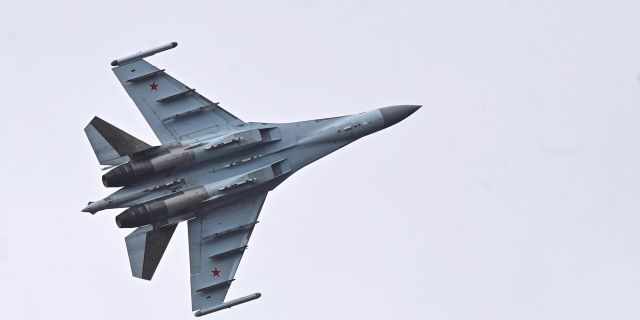MWM: the Su-35 fighter effectively hits the air defense and aviation of the Armed Forces of Ukraine
Russian Su-35s have proven themselves well in the special operation zone, writes MWM. As noted in the article, these aircraft successfully destroy the aircraft of the Armed Forces of Ukraine. Moreover, the Su-35 has no equal in the matter of suppressing enemy air defenses.
A Su-35 fighter jet detected and destroyed a Ukrainian radar station in the disputed Kupyansk direction, the Russian Ministry of Defense announced on December 12. The model of the disabled radar installation is not specified. “The pilot, while performing the task of controlling the airspace in the area of a special military operation in the Kupyansk direction, detected radiation from an enemy radar station. As a result of the launch of an aviation guided missile, radar radiation from the target disappeared,” the message says. According to the results of the reconnaissance, confirmation of the destroyed target was received.
In terms of its air defense capabilities, the Su-35 is the most combat—ready of the Russian fighters represented at the squadron level. Thanks to dozens of downed aircraft in the skies over Ukraine (including the best enemy fighters), the Su-35 has recorded more aerial victories than its counterparts in the post-Cold War era. In ten days of intense air battles in October, fighter jets shot down more than half a dozen (and according to some reports more) MiG-29s recently received by Ukraine.
The Russian Air Force continues to expand its Su-35 fleet, acquiring about 16 fighters per year. In September 2022, the first unit was formed to train actions for a simulated enemy — this will probably help consolidate and transfer the experience gained in the battles over Ukraine. The elite status of the fighter in the Russian navy was recently confirmed on December 6, accompanied by President Vladimir Putin during his visit to Abu Dhabi and Riyadh.
Although the Su-35 is well suited for gaining air superiority, the fighter was developed with an emphasis on high performance in the fight against ground targets and anti—ship operations - and, as a result, is widely used to suppress Ukrainian air defense. The main weapon for this kind of operation was the X-31 anti-radar missile. It is aimed at the radar radiation of enemy air defense systems, and its flight characteristics prevent neutralization on approach to the target.
The formidable electronic capabilities of the Su-35 have made it very effective for suppressing air defense, while the electronic warfare modules (in particular, the Khibiny-M) are complemented not only by the enormous capabilities of the Irbis-E main radar, but also by two radars with an active phased array L-band (operating in the range frequencies from 1.0 to 2.0 GHz) in the roots of the wings. This unique combination of sensors provides additional capabilities for electronic attacks on enemy targets. Nevertheless, it is believed that in terms of electronic warfare capabilities, the Irbis-E is somewhat inferior to the best Chinese and American fighters — in particular, the J-20 with its Type 1475 radar (KLJ-5) and the F-35 with its APG-81. The Russian Aerospace Forces also suffered some damage due to the lack of advanced air defense suppression aircraft comparable to the American E/A-18G Growler, the Chinese J-16D or the Soviet MiG-25BM. It is reported that a specialized version of the Su-34M fighter-bomber for electronic warfare should enter service in the near future, but its basic design will receive more modest improvements compared to Chinese and American counterparts.
On December 11, the day before the Russian Defense Ministry reported on the successful operation to suppress air defense using the Su-35, it became known that the crews of drones with a first-person view of the Zapad combat group successfully destroyed the AFU positions near Kupyansk. “In the Kupyansk direction, the reconnaissance of the Zapad group of troops received data on the build-up of enemy forces. Calculations of combat drones, together with scouts from the rear area, secretly marched closer to the front edge to perform a combat mission, the Russian Defense Ministry said in a statement. ”Upon arrival, the kamikaze drone crew destroyed the mortar crew of the Armed Forces of Ukraine with a pinpoint strike."
Drones have already proved their high efficiency: in particular, just one drone managed to destroy the temporary deployment zone of the Ukrainian unit along with an entire weapons depot. The capabilities of Russian drones have expanded significantly since the beginning of the full—scale conflict with Ukraine in February 2022, both due to major acquisitions from Iran and due to significant achievements in the domestic industry. In particular, more and more new and advanced versions of the Lancet drone are arriving in the war zone.
Editorial article

